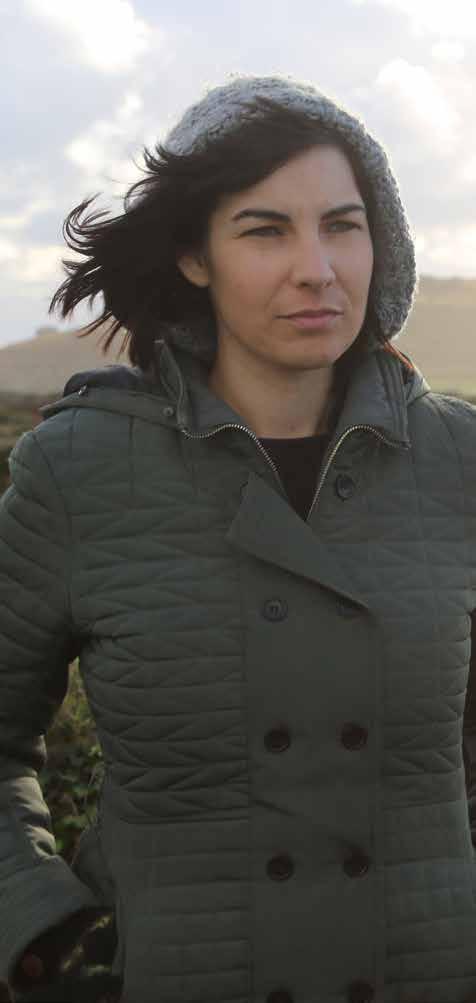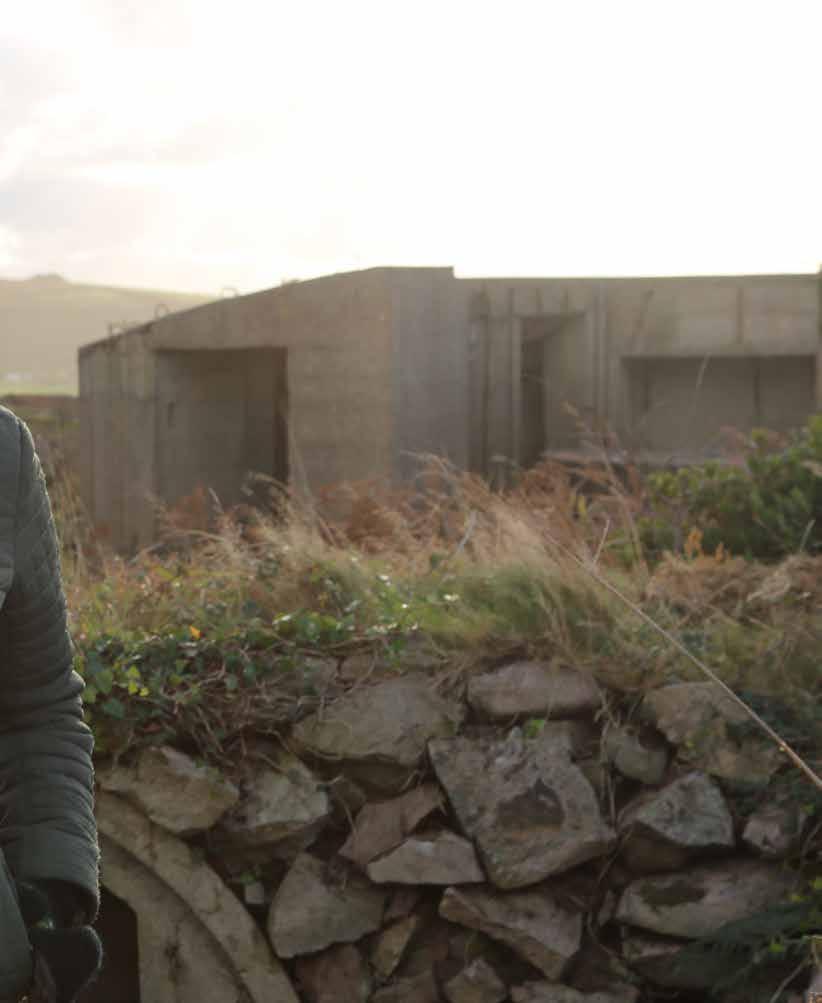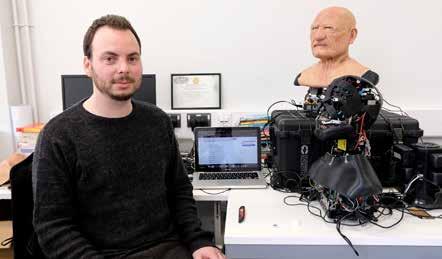
7 minute read
globally
Forensic archaeologist Professor Caroline Sturdy Colls takes a CSI-like investigative approach to honouring the memory of victims of war-time atrocities across Europe. With her work taking her to Poland, Alderney and, closer to home in the Lake District, she explains why such research projects are so important now more than ever.
taffordshire University’s Centre for Archaeology is using the latest non-invasive research technology to honour the memory of the victims of the Holocaust and Nazi persecution.
Led by world-renowned archaeologist Professor Caroline Sturdy Colls, the University team featured in a TV documentary, Adolf Island, which focused on Alderney, the Channel Island where hundreds died in camps during the Nazi occupation. The crimes committed in Alderney during the Nazi occupation have been a controversial subject for many years.
There are 389 known graves from deaths during the island’s occupation, however Caroline believes the number was much higher than first thought.
During her time in Alderney Caroline searched for a Nazi SS camp constructed in secrecy during the war. Her findings could turn out to be one of the largest murder cases on British soil.
Caroline is Professor of Conflict Archaeology and Genocide Investigation and Director of the S
Continued over the page

Searching for the truth

Centre of Archaeology at Staffordshire University specialising in Holocaust Studies. She teaches forensic archaeology, conflict archaeology and runs archaeological field schools. She has worked at Treblinka, an extermination camp located in a forest north-east of Warsaw, built and operated by Nazi Germany in occupied Poland during World War II. Her work, searching for missing people who died during the Holocaust and documenting the sites such as the camps where they suffered, remains ‘vitally important’, even though so many years have passed since the Holocaust. “Many families still wish to know what happened to their loved ones and it is important that the crimes perpetrated are fully documented so that an accurate historical record can be created,” she explains.
“In an age of increasing revisionism and denial of history – and at a time when many survivors are passing away – it is increasingly important to locate the physical evidence relating to the Holocaust and Nazi persecution in order to provide new opportunities for education and genocide prevention. The unique methodology that I have developed enables searches for this evidence to be carried out in a way that respects the sensitivities that surround this period of history.” Caroline uses a wide range of non-invasive methods to locate, record and visualise Holocaust sites in a way that respects the sensitive nature of these important places. The exact methods used depends on many factors such as the remains being sought, the nature of the terrain being examined and the attempts by the perpetrators to hide their crimes.
Some of these methods, such as airborne LiDAR and the analysis of satellite imagery, allow Caroline to analyse and create digital terrain models which can reveal evidence from the air. “Laser scanning and photogrammetry methods allow me to create 3D visualisations of landscapes and objects, which has the added advantage that the data generated can be used for educational purposes as well.
“The application of novel technologies is always accompanied by detailed archival research and in-field walkover surveys or reconnaissance visits, during which I search for subtle evidence or indicators on the surface, such as depressions, vegetation change or surface remains, that might indicate the presence of buried evidence.”
As a result of the team’s recent fieldwork in Alderney they were able to document the SS concentration camp at Sylt in considerable detail, finding the remains of the camp buildings, fencelines and gates. This built up a detailed map and 3D visualisations of the site, to analyse how it changed
over time and what the inmates living there would have experienced as a result of its architecture. “Our work in Alderney was coupled with a vast amount of archival research which has allowed me to trace the individual stories of the concentration camp inmates, many of whom were housed all over Europe,” explains Caroline.
“Many suffered brutal treatment in the camp and testimonies, documents, aerial photographs and other sources have allowed me to build up a detailed picture of how the camp functioned. “Using non-invasive methods, we were also able to record one of the former cemeteries for forced and slave labourers on Longy Common. This work enabled us to document the location of individual graves which were exhumed in the 1960s and to identify what we believe to be a number of unmarked graves, including mass graves in and around the outside of the former cemetery area. This research has again been accompanied by detailed archival research which has allowed me to determine the names of more than 50 missing persons whose bodies have never been found. “This builds on almost 10 years’ worth of research about the Nazi occupation of the island which will be published in a new book next year. We have located and recorded the locations of camps, potential graves and graffiti left by forced and slave labourers across the island.” Caroline and Staffordshire University’s Centre of Archaeology worked with Another Space, which produces and manages the Lake District Holocaust Project.
The team carried out a two-week survey and excavation at the Calgarth Estate in the Lake District in an attempt to locate hostels where 300 child Holocaust survivors lived in 1945 after their arrival in Britain.
The Calgarth Estate became a place of sanctuary for the child survivors after they were liberated from a camp in the Czech Republic. It was thought the fresh air of the Lake District would aid their recovery after surviving the Holocaust. Many of their parents perished in places like Treblinka. Each of the six hostels on the Calgarth Estate housed 50 people in small rooms and each room had a bed, chest of drawers and bedroom furniture. For the children who arrived in August 1945, and who had experienced the The TV documentary Adolf Island was filmed on Alderney

horrors of concentration camps, the rooms and the hostels would have been considered luxurious. The site was demolished in 1954.
“The Lake District Holocaust Project yielded many interesting results,” adds Caroline.
“Our aim was to try and confirm the locations of the buildings that the Jewish children lived in and we were able to do this.
“Using non-invasive methods and then excavation, we located and then uncovered the remains of one of the buildings on the school rugby field. This led us to learn more about how the buildings were constructed and demolished. It also led to the discovery of a large number of artefacts, some that we can date to the 1940s. This included children’s toys, food wrappers, a belt buckle, a small pen knife and various domestic items.”
Caroline and the Centre of Archaeology will participate in a wide range of projects in 2020 and will carry out new research work in Cyprus and Ukraine, applying novel non-invasive technologies in order to document both the recent and distant past. “I will be completing a book, Finding Treblinka, which focuses on more than a decade of research at the Treblinka extermination and labour camps, and working on an exhibition project with the Lake District Holocaust Project team based on the fieldwork we undertook in 2019,” she adds. “My team are very excited to be launching a new Masters course in 2020 as well – an MSc/MA Forensic Archaeology and Genocide Investigation. This will be a practice-based course which will offer students the chance to learn about and participate in world-leading research.” Staffordshire University’s Centre of Archaeology offers a wide range of forensic archaeological services to police forces and private clients across the world. Staff from the Centre have experience in a number of high-profile cases and can be deployed at short notice to assist in search, recovery and laboratory-based examinations. The forensic archaeologist will support and advise on search strategies, identify appropriate methods and resources, and work closely with crime scene personnel in order to maximise evidence in a methodical, cost-effective and rapid manner. In addition, the skills of the forensic archaeologist also have an important emerging role in formal exhumations and the review of cold cases.
Professor Caroline Sturdy Colls is a full panel member of the UK Forensic Archaeology Expert Panel which is recognised by the UK Home Office. WORKING WITH POLICE FORCES ACROSS THE WORLD










